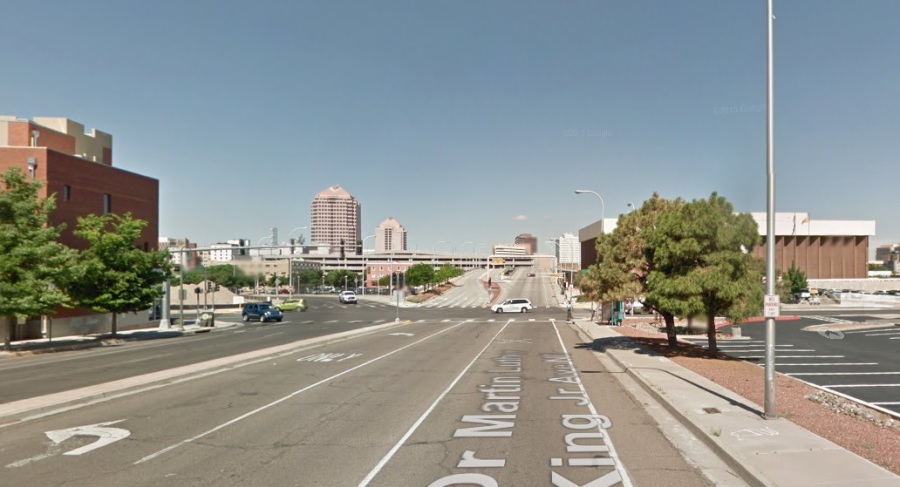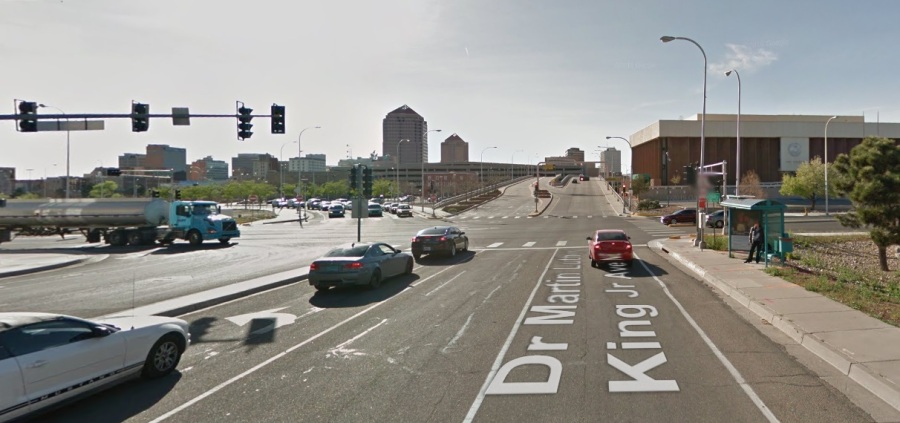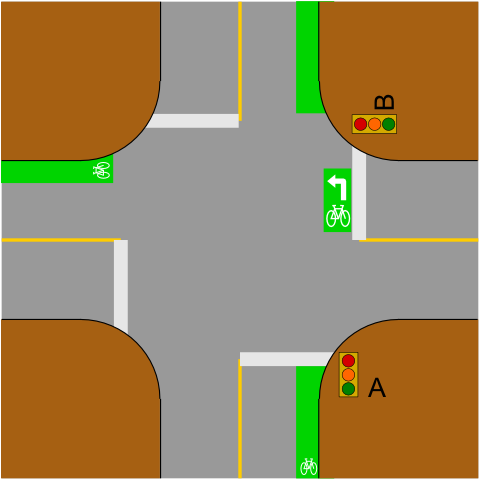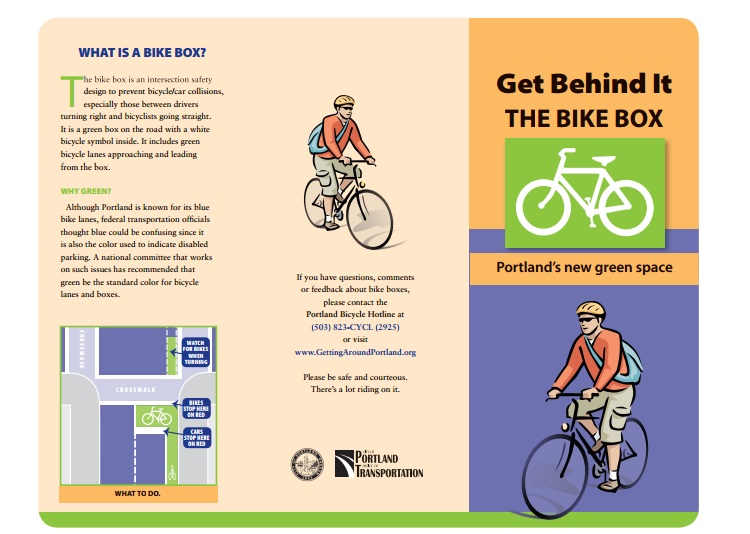For those Burque cyclists who dare to ride among traffic in our fair city, there are many challenging intersections. One of the diciest, historically most dangerous and also important is MLK, Jr. Blvd. and Broadway. MRCOG data for 2008-2011 showed it to be so, and the corner was site to two cyclists deaths in separate incidents over three days in 2015.
Why is this so and what can be done about it?
A look Westbound on MLK via Google Street View is helpful in multiple ways here. First, here’s the intersection largely devoid of motoring traffic:

Yes, that’s a bike lane on MLK; you can even just make out a cyclist waiting at the red light on that lane. Your author commuted back from work using MLK for years, similarly, it appears this rider plans to go straight at this light and up/over the bridge on what has become Marquette.
The issue from this perspective isn’t going straight across, it’s turning left onto Broadway. In the almost idyllic photo above, most cyclists wishing to turn left here would cut across to the left turn lane, just like a motor vehicle. There’s no traffic (be sure to look behind you!), so what’s the problem?
Well, let’s take another Street View look, as fortunately the Google Street View Car evidently visited MLK Westbound right around the time of my weekday afternoon commutes:

Ah, this is more like it!
While straight across MLK to Marquette is only changed by the fact all those left lane cars across on Tijeras will be coming north onto Broadway in front of the Westboud cyclist, the big differences are for those wishing to turn left/South on Broadway. And yes, there’s a big ‘ol truck involved in the equation here, just for added degrees of overall sightline difficulty.
As is the case in many such situations, the cyclist is faced with the question: Do I stay in the bike lane or insinuate myself into that left turn lane? This question is something of a zen koan in that there’s not one 100% agreed upon answer here. On top of the logistical factors (for instance, is that white car gonna leave that space where the left arrow is for me to sneak in there?), there’s the far more permanent factor of an individual rider’s comfort zone.
Me? Personally? If I absolutely had to turn left here, to go, say, to the First Baptist Church (an unlikely scenario, but work with me here), I’d do it, but I’m much more likely to stay in the bike lane. If I needed to go anywhere on Broadway south of MLK, I’d probably have chosen to take Lead into downtown in the first place.
In other words, I’m really uncomfortable turning left in that photo above.
And that gets us to the whys and hows of Albuquerque, in particular the City of Albuquerque, needed to teach its road-using public some Danish.
It goes by different names, but as the idea purportedly took off in the Danish capital, the image below depicts one version of what’s called a “Copenhagen Left.”

Those who are at all picky could rightly point out that the image above isn’t exactly what is entailed at MLK/Broadway, but it’s a start. The idea is general is for cyclists wishing to turn left to first go straight across (in this case Broadway), then stand in a bike box (or other such designated area, this is often not in the lane as shown here, but is part of the sidewalk design) to wait for a safe time to cross what would in this case be both Marquette and Tijeras.
But there are many complexities to MLK/Broadway, and one doesn’t deserve the title of “picky” in pointing them out, including the interesting wrinkle that Broadway has a bike lane at MLK that quickly transforms into a parking lane as shown below:

No Burquean has ever complained that riding a bicycle here is too easy.
Aside from the myriad complexities and nuance, there’s also the educational aspect to the Copenhagen Left. How does the City teach both cyclists and motorists what the heck this arrangement of lane and boxes means? More importantly, how do we teach folks without having to kill a few of us in the process?
Educational efforts such as this are increasingly legion as the number of ideas toward greater bike/ped safety has, fortunately, increased. For example, CABQ just released an instructional video on how to use/interact with a “HAWK” signal, which seems a bit other than timely, as the HAWK has been in place for months. Perhaps it’s unfair to also point out that the YouTube page for the CABQ effort currently shows it to have had 176 views to this point.
Unfair or no, instructional videos, modern PSAs, work even less well in the Internet Age than they did in the heyday of PSAs. Unless something goes “viral,” online/visual education is a bust, and one doubts even a J.J. Abrams-directed Copenhagen Left instructional video would make much of a viral dent.
In his look at Danish and Swedish cycling patterns, Clarence Eckerson, Jr. of Streetfilms.org cites the importance of childhood traffic safety training in grade school for all modes of travel as the biggest factor leading to the very high level of cyclist/motorist cooperation and very low collision rate. David Hembrow at “A view from the cycle path…” in the Netherlands poo-poohs formal training classes and points to the pervasive use of bikes at an early age by the Dutch as the biggest factor in creating a cycling education culture there. He also stresses the unsurpassed degree of bike infrastructure to help this process.
Back in the States, most U.S. cities, including CABQ with the HAWK, have tried distributing educational brochures. Here’s Portland, Oregon’s attempt at enlightening citizens on bike boxes:

Even simpler questions of distribution follow such efforts: Does someone stand at the corner of MLK and Broadway with “Copenhagen Left” brochures? Does that someone stand in the median below and go car-to-car in the left-turn lane passing them out ala typical fundraising efforts in the South Valley? Or do we spend big bucks and put them in monthly water bill notices?

As stated earlier, the complexities of the tableau shown above go well beyond the Copenhagen Left and education: For instance this short “analysis” hasn’t even brought up:
- That bus stop in the photo above;
- The high number of cyclists who ride the sidewalk here, in part due to a lack of rider education, and also due, in part, to just how daunting the intersection is; and,
- The tentatively to almost finalized planned overall revamping of MLK by CABQ from University to this intersection, including a possible Copenhagen Left, and talk of dramatic changes of Tijeras that would fundamentally change the danger level here for all modes of traffic.
Whatever the eventual solution here, and in unfortunately near countless similar danger spots around town, Burque is going to need to further refine and succeed in its education of road users. Complexities and multiple improvement solutions aside, that’s a dead-on certainty.
Might I suggest that bicyclists use the crosswalks to navigate dangerous intersections. While it would mean stopping for a bit and waiting for the light, it would be far easier than trying to teach this city (of remarkably bad drivers) to change its driving habits. Yes, it is an imperfect solution, but no less than attempting to make more road rules that half of the city won’t understand and the other half will ignore outright.
Please understand, I’m not trying tear down this idea; personally, I think it is great. It’s just that I’m afraid that these bike boxes will lead to many fatalities due to an uninformed and uncaring public.
LikeLike
The HAWK video is up to 178 views! (The education piece is a hard problem.)
LikeLike
Mark: WordPress isn’t letting me copy/paste images in comments, but if you go to the Clarence Eckerson link mentioned above: http://www.streetfilms.org/videos-from-stockholm-malmo-copenhagen-featuring-cph-driver-patience-vision-zero-and-nyc-bike-lane-future/
you’ll find an image of a Copenhagen Left that approximates the crosswalk approach, putting the “bike box” area immediately adjacent to the sidewalk/crosswalk.
John, concerning education, I’m reminded that traffic gurus use “85th percentile” in determining speed limits, with the idea, roughly, that 85% of us are reasonable and prudent drivers. http://onlinemanuals.txdot.gov/txdotmanuals/szn/determining_the_85th_percentile_speed.htm
Of course, the only problem with is the remaining 15%, and it only takes one, as we cyclists always keep in mind. Educating the 85% is incredibly daunting, but reaching that 15%? Unfortunately, the only way to reach them might very well be AFTER the crash and carnage.
LikeLike
“A look Eastbound on MLK via Google Street View “. I think those views of MLK are Westbound, toward downtown. Not that it changes anything in the description.
LikeLike
Thanks Michelle. I have some directional dyslexia when it comes to this stuff, I’ve noticed. Changed above and thanks for the catch. – Scot
LikeLike
[…] extensive planning (and noted here a few weeks back), Albuquerque’s Department of Municipal Development (the road people) has announced bike […]
LikeLike